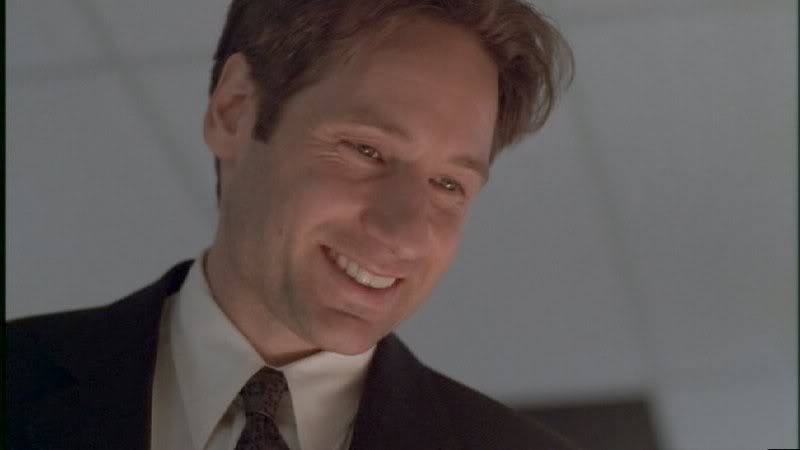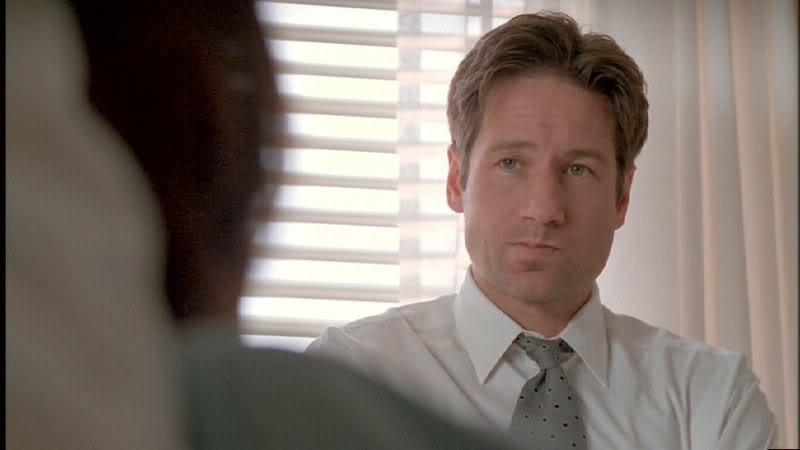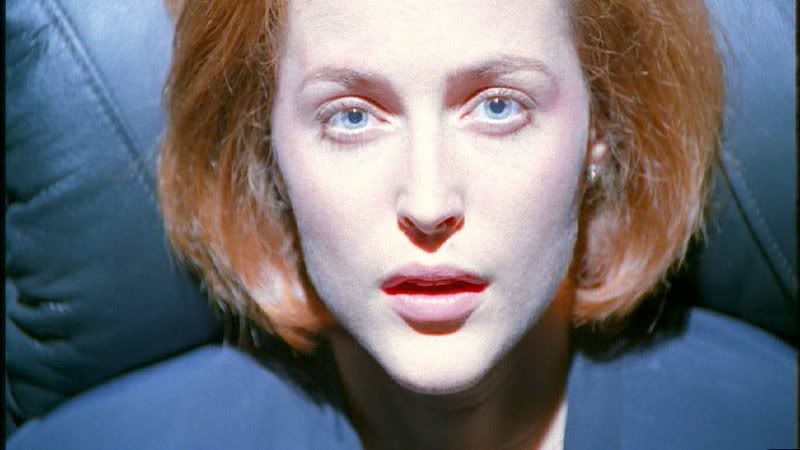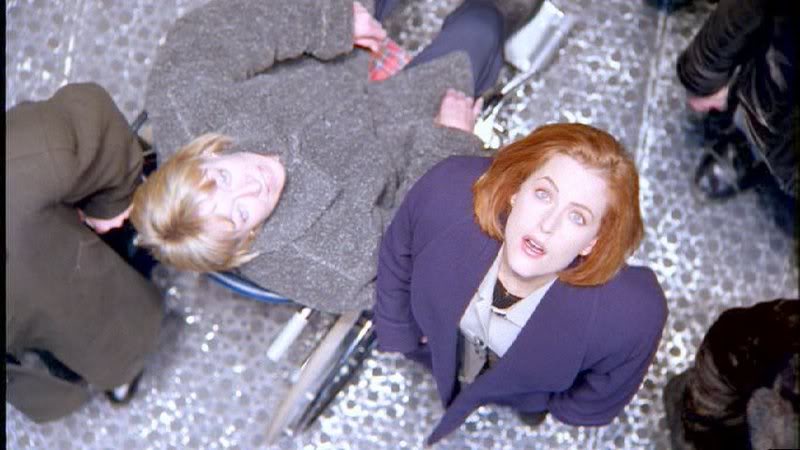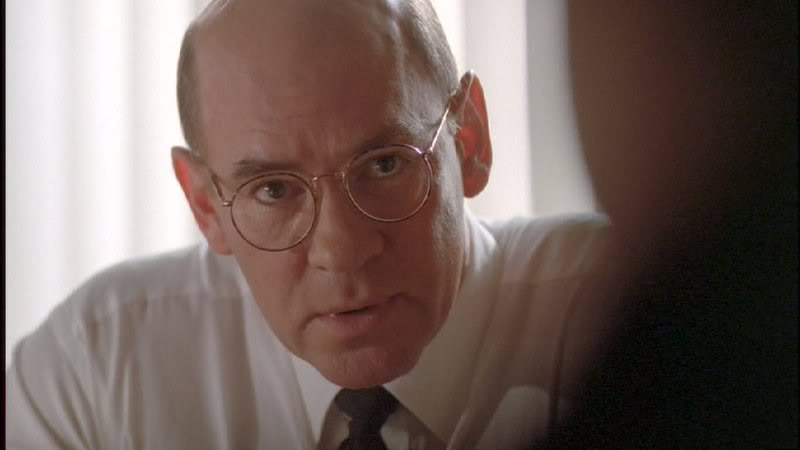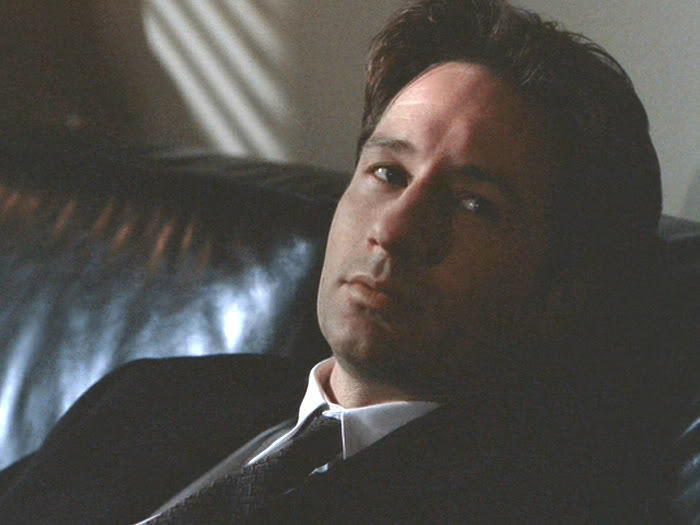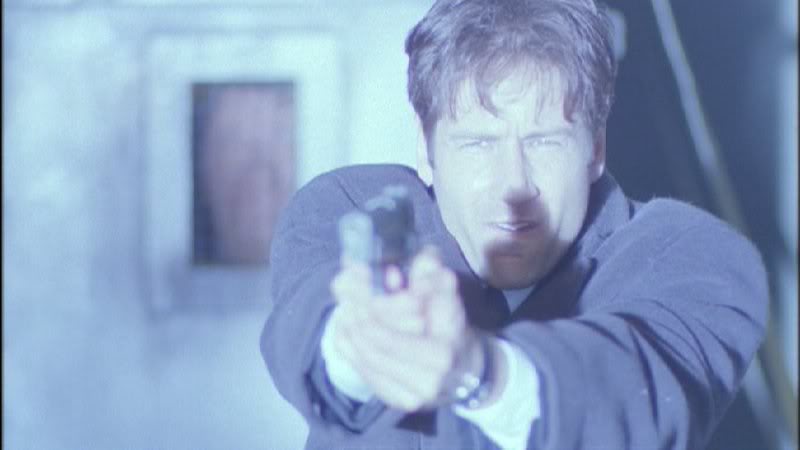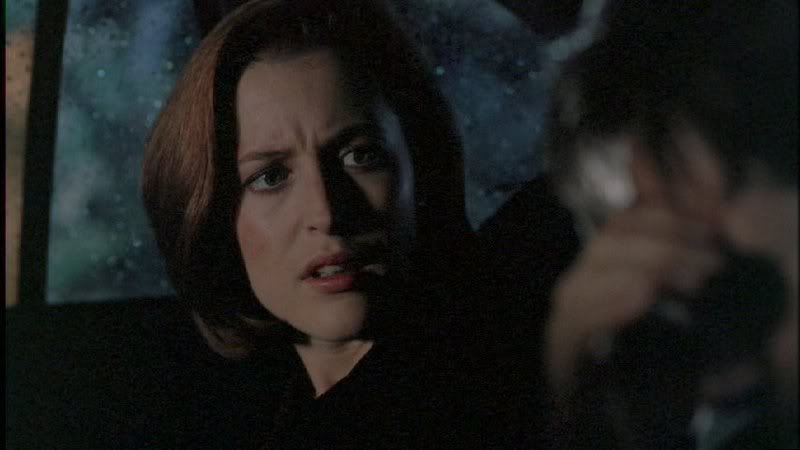REPOST -- CTP Episode of the Day - 04.07.06 - The Red and the Black
Today's Cherished Episode: The Red and the Black (5x14)
Original Air Date: March 8, 1998
Written By: Chris Carter and Frank Spotnitz
Directed By: Chris CarterThe world turned upside down: Recovering from a near-death experience, Scully is convinced that her memories of alien encounters are true. For his part, Mulder clings to skepticism and science and uncovers new, even more dangerous, conspiracies.
Some "The Red and the Black" Tidbits & Musings:
"It all comes down to a question, Scully. One that hasn't been answered or I don't even think honestly addressed. Who made that chip in your neck? That chip was found in a military research facility. Our government made that chip, implanted it in your neck as part of a secret military project to develop a biochemical weapon, to monitor your immunity, or to destroy you like a lab rat, if the truth were to be exposed. Your cancer ... your cure ... everything that's happening to you now - it all points to that chip. The truth I've been searching for? That truth is in you."
Some "The Red and the Black" Tidbits and Musings:
-- Title: There was a huge amount of speculation among X-Philes over the significance of the title of this episode. The most likely theory regarding the origin of the title is from a film made by the American government in the 1950's, during the height of McCarthyism. Used as both entertainment and anti-communism propaganda, the film was filled with truly astonishing stereotypes of "Commie Bastards." The film also depicted the cold war as a clear-cut battle between good and evil, with Americans as the patriotic freedom-fighters and the Russians as a threat to all that the Americans held dear. The title of this film was The Red and the Black.
-- Another interesting suggestion was that the title was a reference to Stendhal's book Le Rouge et Le Noire, French for The Red and the Black. The main character in the book (Julien Sorel) is an angry, self-made man who hates the rich people who don't accept him because he was born poor. The book follows his life as he manipulates and connives to advance his career and his status in life. The title of the book relates to two life-choices that were available to Sorel, the army or the priesthood. Eventually, the character's past comes back to haunt him, and he loses everything.
-- Tagline Change: "Resist or Serve," which comes from Krycek's dialogue about colonization in Mulder's apartment -- "... a battle is being waged. A struggle for heaven and earth. Where there is one law: Fight or die. And one rule: Resist or serve."
-- "Resist or Serve" was also used as the title for the X-Files Playstation 2 game released in 2004.
-- "Patient X" and "The Red and the Black" "were big events in the X-Files mythology, a way of establishing the mythology by providing a threat to it," explained Chris Carter. "The episodes' revelations about Earth's potential alien occupiers were all important clues to the emerging bigger picture and essential plot elements leading to the X-Files movie and ultimately to the end of the series."
-- "We were taking chances by playing with the beliefs of our main characters at this point," said Carter. "But I think taking those chances made it that much more interesting. I always think of the show in two stages. It had its first life in Vancouver and its second life in Los Angeles. And it just happened that we started changing the direction of the mythology of the show at about the same time we were preparing to move to Los Angeles."
-- "About the time this two-parter was filmed, I was coming off one of the busiest years of my life," Chris Carter said. "Not only was I working on production of X-Files, but I was also working on the first year of Millennium and doing the pre-production for the X-Files movie. I had taken about 10 days off to write when Frank [Spotnitz] asked me to come and direct 'The Red and the Black.' Frank thought the episode was so important to the narrative path to the movie that he thought I should direct it. So I agreed when I was right in the middle of all this other work."
-- The episode's opening "insert shot" -- words being typed on a page -- was one of the most difficult ever done for the show. "Shooting something on such a tight focus point was difficult," recalled Carter. "We spent about a day just shooting that insert scene of the typing."
-- The messenger boy was Jack Finn, son of X-Files producer J.P. Finn.
-- The scenes outside the snowbound cabin were filmed at Grouse Mountain, a short distance from downtown Vancouver. "The day we were shooting up there," said Chris Carter, "Brian Thompson [the Alien Bounty Hunter] stopped by to visit us on the set. He was up there snowboarding."
-- "Patient X" and "The Red and the Black," stuffed with special effects, elaborate sets, and difficult locations, were also the most challenging and logistically complex projects of the fifth season. "Well before the Christmas break," said locations manager Louisa Gradnitzer, "Chris came to us about these two episodes and he told us what he wanted was 'a spectacle,' something that dominated the landscape."
-- After several scouting trips to hitherto unfilmed local wonders -- including the Squamish Chief, a massive granite mountain near the British Columbia resort town of Whistler -- to find the "spectacle spot" that Carter wanted, the location chosen was Ruskin Dam, a 70-year-old hydroelectric facility located approximately fifty miles east of downtown Vancouver.
-- "What was great about Ruskin Dam was that it had this wonderful 'industrial gothic' look -- and we'd never done anything there before," added Gradnitzer. The dam could be rented from the local utility, B.C. Hydro, for a reasonable fee, plus $1,400 each hour that water was diverted from the generators to cascade dramatically into the water below.
-- "This was the first time I had worked with helicopters as a director and because of the site we were using, it was very difficult -- for me and for the helicopter pilots," Chris Carter said. "But one of the coolest things was that I actually went to work in the red helicopter seen at the beginning of the first act. That helicopter took me to Ruskin Dam on the first day of shooting there."
-- Perhaps the most striking footage in the two-parter was obtained by the small fleet of helicopters that hovered over the dam site almost constantly. On one memorable day, for instance, the civilianized Huey that doubled as the red Search and Rescue chopper was sent up just minutes before sunset to film scenes of devastation on the bridge's roadbed. At the last possible moment the craft swooped over and below the dam; settled into a hover alongside the active spillway; got the shot as monitored by director Chris Carter gazing at a ground-based video feed; then landed on the roadway by the entrance. The pilot kept his engine running, but Carter indicated his approval. The crew applauded, then started to pack up for the journey home.
-- Carter opted for slow motion to show Mulder walking among the carnage on the Ruskin Dam Bridge as a way of "playing with time."
-- "We had beautiful weather while we were filming at the dam," said Carter. "Weather contributed so much free atmosphere for us while we were in Vancouver and it usually cooperated. When we were shooting 'Humbug' during Season 2, which was set in Florida, we needed to have a week of sunshine and we got that. And for this episode we got the sunshine we needed at the dam."
-- The burned bodies on the bridge lying partially incinerated at the dam site following the rebel alien attacks were created for the episode by the prop and production design departments under the direction of special effects makeup supervisor Tony Lindala. Lindala also supervised the creation of the faceless aliens and the facial mutilation of young Dmitri. After experimenting on his brother Robin, Lindala also designed the rig that allowed alien oil to ooze into Dmitri's face (in "Patient X"). Actually the oil oozed out until the film was reversed in the final edit.
-- Lindala said, "Let's see -- we broke his nose a little bit, we had his left eye swollen shut, then we had a tube rigged that was set up to come underneath, then just over his ear, underneath his left eye, and down his nostril, and then a separate little denture rig with a balloon bladder in it that we filled with this oil. He could squeeze the bladder with his tongue so that both his nostrils and his mouth oozed this black oil. We had to get him set up in a certain position so that gravity worked in our favor. But in reverse, it looked really neat."
-- Carter called the brief scene inside the medical tent where Mulder found Scully "my homage to E.R. It's very challenging to use a steadicam with actors moving in and out of the scene, and they make it look so easy week after week on E.R."
-- The scenes of Marita in an unknown medical facility were filmed at an abandoned hospital in Vancouver. "It had a really interesting observation space above the operating room," said Carter, "and we decided to make us of it for the two episodes."
-- The Uroff-Koltoff Star of Russia ship was named for Steve Uroff and John Koltoff, two childhood friends of Chris Carter's. The three boys grew up in Bellflower, California; Uroff and Koltoff lived on Cornuta Street and -- something I never knew before -- Chris Carter grew up on a dead-end street named Hegel Place. (Sound familiar?) "After 'The Red and the Black' aired, I got a nice letter from John Koltoff who I hadn't seen for 20 years," said Carter. "Mostly I made my friends dead people on The X-Files, so naming a ship for them was a nice chance to do something other than that."
-- "Patient X" and "The Red and the Black" featured a huge cast of principals and extras, "much larger than most cast lists for a TV series," explained Carter. "We were able to convince the studio to spend the extra money to do this extra special work because it was all leading up to the release of the movie. So there was a synergy that we had never seen before between the film unit and the TV branch of 20th Century Fox. The film branch was very good to us because The X-Files TV series had made a huge amount of money for Fox."
-- Wiekamp Air Force Base was also named for a childhood friend of Chris Carter's, Warren Wiekamp. "I got my first hit off him as a 10-year-old baseball player," recalled Carter. "I hit a double off him which was very important to me at that time -- and I guess remains important to me even now."
-- A maximum-effort set piece in "The Red and the Black" was the crashed alien spaceship. At Chris Carter's direction it was built sixty feet in diameter, twice the size of any alien craft previously fabricated for the show. The steel-hulled spaceship was constructed, then transported to an open area -- the same one used for the oil well explosion in "Terma" -- and dragged along the ground to leave a sixty-foot-long skidmark to simulate an impact zone, with a huge mound about 30 feet tall at one end. Special effects supervisor Dave Gauthier set off twenty-five closely spaced explosions to simulate the saucer crashing to a halt in flames; he then burned the rest of the wreckage to get a shot that lasted no more than a few seconds.
-- "It took an entire night to shoot the crashing spaceship scene," said Chris Carter. "There were no special effects used for the scene -- it was all done with the camera and with explosives."
-- "I had one very odd but vivid memory of shooting the scene between Mulder and Scully in her hospital room," Carter said. "It was a very small space we were shooting in, very cramped, and we were filming Gillian's one-shots. David wasn't even in the room. Gillian was acting and I realized very early on it was a take I didn't like but I let her go because I thought we might be able to use part of it. During her dialogue, I looked at my watch; and I don't think she actually saw me look at my watch, but she sensed that I looked at my watch -- she was so sharp that she just realized it. I didn't even know she knew I was in the room. And without actually looking at me she sort of scolded me for doing that -- looking at my watch -- and as the director disrespecting her performance. That's just how good she was."
-- "At this point in the mythology it started to write itself," said Carter. "We had made such a tapestry of events for a narrative that when we started to put the pieces together they actually started to fall together almost magically. The story sort of dictated itself to us in so many ways because of the connections that had been made. The one new element introduced at this time was Jeffrey Spender; and that was the thing that actually vaulted us forward past this point and into a new chapter of the mythology."
-- "From the very beginning of the show I told every director not to shoot too wide, to keep a really tight eyeline," Carter explained, "because I wanted the viewer to put himself in the character's head. I wanted the viewer to be afraid for the character or be afraid with the character. It allowed you to be a subjective viewer instead of an objective viewer, letting the camera play that part."
-- "I think some of the best visual work we did on the show was done during seasons five and six," Carter said. "Joel Ransom came in and used the template that had already been designed by the three directors of photography that preceded him and made it better. And he did it cheerfully -- he was one of the most cheerful people I have ever known."
-- The legend lists the Office of Dr. Heitz Werber as being located in Silver Springs, Maryland. The actual name of the town in Maryland is Silver Spring.
-- Carter noted that the two-parter marked the return of the character of Dr. Heitz Werber, introduced in the "Pilot," and recalled that before the "Pilot" was filmed, he received a note from the network which said Dr. Werber should not speak with an Austrian accent. Said Carter, "I think they thought we were casting Sigmund Freud."
-- The character of Dr. Heitz Werber was loosely based on Dr. John E. Mack, professor of psychiatry at Harvard Medical School since 1956, mostly teaching psychoanalysis to residents. Mack was also an acclaimed researcher and author; his biography of British-born Arab warrior T.E. Lawrence, A Prince of Our Disorder, won the 1977 Pulitzer Prize for biography. Mack was originally a skeptic about those who believed they had been abducted by aliens, at one point writing in a research paper that those who believed "must be mentally disturbed."
-- But in 1990 Mack began to take a closer look, and several puzzling phenomena intrigued him: Young children and abductees in far-flung locations gave similar accounts; many abductees showed consistent injuries such as distinctive cuts and marks on the skin. And often abduction reports accompanied independent sightings of strange lights or flying objects.
-- Mack plunged into study, founding a Harvard-affiliated academic center, PEER (Program for Extraordinary Experience Research) through which he evaluated hundreds of abductees and co-sponsoring the 1992 Abduction Study Conference held at MIT, and published his findings. In his book Abduction: Human Encounters With Aliens (1994), he documented his science -- examining experiencers by taking psychological histories, performing batteries of standard clinical tests, and conducting extensive interviews. Mack also used regression hypnosis in his study, saying that the technique was valid both diagnostically and therapeutically.
-- Mack's book created a highly-publicized controversy about the nature of the abduction experience and the treatment of abductees by therapists and counselors. His conclusion: Experiencers were authentic -- not mentally ill. His theory: Some powerful intelligence was trying to intervene in human affairs. All of which, not surprisingly, drew rebukes within the academic community.
-- After being investigated for more than a year by the Harvard Medical School for allegedly "affirming the delusions" of patients who believed themselves to be alien abductees, a special faculty committee decided that Mack could retain his tenure and decided against censuring him for his conduct. The publicity surrounding Mack’s problems at Harvard only increased interest in alien abduction, which Chris Carter claimed to have been an important influence upon the development of The X-Files.
-- "I found it fascinating to hear this man, Dr. John Mack of Harvard, in the highest level of academia and a scientist using rigorous scientific methods had come up with something quite astounding," said Carter in an interview. "So I thought that was a wonderful entry into explorations of the paranormal. And so I came up with Mulder and Scully, the FBI, and this fictional investigative unit called The X-Files."
-- Carter later met Dr. Mack at Harvard and was invited to sit in on a regression hypnosis session of a person believing themselves to be an alien abductee. Scully's hypnosis session in "The Red and the Black" was based on that experience. "To sit there and actually witness the regression was amazing," said Carter. "I still consider myself a skeptic, but the reality of sitting next to someone reliving that experience was freaky for me."
-- Dr. John Mack died on September 27, 2004, after being hit by a car in London. In an X-File sort of coincidence, his cremation ceremony was held on October 13 of that year.
-- Filming the actual alien abduction scenes on location was impractical, so construction supervisor Rob Maier launched his biggest project of the season: a nearly full-scale replica of the Ruskin Dam Bridge, in wood and steel, was built from scratch inside a cavernous A-frame warehouse in the nearby town of Delta. "We built that bridge," said Maier, "an exact replica other than that it was one section shorter than the real bridge. But every other detail was the same, including the 50,000 rivet heads we put on each of the I-beams."
-- "Chris was really exploring the other side of the mythology as everyone on the crew knew it at that time," said unit manager Brett Dowler. "I really remember a buzz going through the office when this script came out: 'Oh my God, he's finally seen these people, he's going to show us these people, this is so incredible.' And we're going -- this? Wow, can we do this? We've got a flying saucer over the top of a bridge? How are we going to do that?"
-- "We rented this enormous sound stage, enormous," recalled Carter, "and we built the bridge, recreated the bridge that was at the dam inside the sound stage, completely from scratch, and the lighting people -- that would be the physical effects person and the director of photography -- created this giant lighting rig which simulated a spaceship and it was so good and so elaborate, they had a big crane that flew it over the bridge, that most of my camera work of it actually took no computer augmentation." The water under the bridge was added through CGI.
-- The lights of the alien spaceship overhead were actually an elaborate high-intensity lighting rig, custom-built by an outside expert who specialized in rock concert light shows, combined with footage filmed at the actual bridge. This complicated combination was done, via computer, by special effects supervisor Laurie Kallsen-George (who was thoroughly drenched by an unexpected spillway cascade during a scouting trip to Ruskin Dam).
-- "Doing the fire shots was very challenging," said Chris Carter. "The stuntman has to be able to do what you want them to do in a very short period of time."
-- To portray the victims of the alien rebels, stunt coordinator Tony Morelli suited up for five "full body burns" -- a single episode XF record at that time.
-- Props master Ken Hawryliw created the alien fire wands out of "materials not found on Earth -- just in Canada"; and after consulting a reference work titled Blue Helmets Under Fire, decided to outfit his entire UN peace-keeping force (see in "Patient X") with Netherlands Army uniforms and ordnance.
-- The abduction of Cassandra Spender was accomplished by placing Veronica Cartwright in a harness suspended by a crane about 30 feet in the air, then lowering her into the wheelchair. "I wanted the effect of particulate matter during the abduction scene," said Chris Carter, "so we created snow to fall around Veronica as she was being dropped into the wheelchair, and when the film was reversed, Cassandra rose from her wheelchair and the snow actually appeared to be going upward." The harness wire was painstakingly erased from the picture during post production.
-- "The snow machine was blowing on my face," said Veronica Cartwright. "Soap suds, which is not too cool when they catch on your nose and you can't do anything and you're suspended backwards on this harness and on the tip of your nose you have this snowflake which is actually like a soap bubble and you're thinking, 'Oh God, don't sneeze, don't do anything.'"
-- "The Department of Water and Power in Canada was unbelievable," said Cartwright about filming on the real bridge during "Patient X." "I mean, they lit the whole top of that dam. They said, 'We'll do that for you.' They lit the whole thing, and then there were so many shots where the dam is in the background and they would turn the dam off because it was making too much noise. Then they would say, 'this will look better if the water was running,' so they would turn the water on. Can you imagine in L.A. ever having that happen? I don't think so."
-- "Sometimes you're lucky enough to find the perfect physical elements that you need for your job," said Carter, "and in this episode I was lucky enough to find two. The sofa that Scully and Mulder were sitting on during her hypnosis scene had a reclining section, and it was perfect for that shot, the perfect piece of furniture. And the truck that was used in the final scene was perfect, had the perfect top for the effect I wanted. That was how it was on our show; you told your crew what you needed and it appeared as if by magic."
-- "As the series progressed, the character of Skinner became essential to the telling of mythology episodes," Carter explained. "He had to be a neutral character, because of his place in the FBI, yet he also had to support Mulder and Scully as their superior. This really appealed to Mitch Pileggi's strength as an actor and I think the mythology made it more interesting for him to play that character each week."
-- The scene between Jeffrey Spender and Scully in the X-Files office was the last time Carter directed a scene on that set before production moved to Los Angeles. "That office set had been standing on the same stage for about four years in Vancouver," Carter recalled. "And it was only used a couple more times in Season 5 before it was burned in effigy in 'The End,' the season finale and our last episode in Vancouver. The set was re-created in Los Angeles, but it was not exactly the same."
-- "Over the course of the show, Mulder's apartment was broken into more times than I could count," Chris Carter joked while discussing the scene where Mulder arrived home to find Krycek waiting for him. "That was always the 'go to' event when we needed to ratchet up the tension. Mulder's door would always get kicked in or beaten down. I don't know why he ever came home."
-- "Many television productions take the shooting script and move scenes around during the course of filming to make the story flow better," Carter said, "but our episodes were usually blocked so carefully that we couldn't move scenes around. All of our actors were very faithful to the dialogue too, mainly because there was never enough time to change the dialogue or to do a lot of improvisation."
-- One exception to that was David Duchovny. "David added his own flavor to scenes, especially when he knew he could make them better," Carter said. "In the scene between Mulder and Krycek, David improvised a lot, adding funnier lines on the spot. David always made things funnier than they were written on the page because he is one of the funniest people I know."
-- "The choice to use lots of close-ups and keep the eyelines tight in the scene between Mulder and Krycek was a wrong one," Carter said as he reviewed the episode years later. "That scene could have used some wider shots but we only had two walls of the set and we didn't have time to put up the third wall for that wider shot. Some two-shots and wider shots would have made the scene a lot more interesting."
-- Carter noted that having Krycek kiss Mulder on the cheek was Nicholas Lea's idea. "I think he always secretly wanted to kiss David Duchovny," Carter joked.
-- In the scene where the Alien Bounty Hunter broke into Wiekamp Air Force Base, actor Brian Thompson jumped up on the fence, but a stuntman immediately jumped down on the other side and ran away. This was done to make it appear that the Alien Bounty Hunter had scaled the fence with superhuman strength.
-- Mulder's line, "Destiny, fate, how to throw a curve ball," was improvised by David Duchovny.
-- Carter recalled that the scene where Mulder and Scully went to the Air Force Base was filmed on a Friday night and Vancouver once again provided the perfect weather for the scene -- a steady rain. "We would usually work 17 or 18 hour days," Carter said, "and usually on Fridays we'd start mid-day then work through a half-day on Saturday, then have Sunday off. So if you wanted to go back to Los Angeles where your family was, you only had that one-and-one-half day to do that, and you had to race down there and then race back. The actors were getting tired of it. I was getting tired of the commute, going back and forth on a weekly basis. It was hard to leave the crew we had in Vancouver, but I think all of us were ready for the show to move to Los Angeles when this season was over."
-- The scenes inside the truck carrying the alien rebel were filmed on a stage. Both the set and the camera were shaken to give the appearance that the scene occurred in a moving vehicle.
-- "The first time we did a morph effect in Season 2, it was very hard to do," Carter said. "But by the time we did the morph from Quiet Willy to the Alien Bounty Hunter in this episode, it was one of the easiest and cheapest effects that we did."
-- Picture car coordinator Nigel Habgood found the perfect truck for Carter for one of the final scenes in "The Red and the Black," but he was momentarily stumped when asked to find a gaggle of Russian passenger cars for immolation in the opening scene of "Patient X." Habgood said, "I couldn't get real Russian cars, so I decided to get creative and go seriously European. We burned a couple of Saabs, a couple of Ladas, some Fiats, a Peugeot, a Skoda, and a BMW 2002. I'm sorry we couldn't get any Yugos. I would have loved to burn some of them."
-- When "The Red and the Black" was filmed, Veronica Cartwright said she believed her character was the Cigarette-Smoking Man's wife, "though I don't know whether I'm still married to him or not -- nobody's told me." Initial plans called for Cartwright to reprise her role as Cassandra Spender in one of the final episodes of Season 5, but that didn't happen when other aspects of the mytharc needed to be wrapped up, so her return was pushed back to mid-season six. "I guess after getting taken up by the alien ship, I come back," speculated Cartwright at the time. "Chris said, 'I don't know if there are real aliens out there, but it's fun to think about the possibility.' And I think he does a good job with that -- creating paranoia."
-- "I had a ball up in Vancouver, and it was so much part of the look of the show," Cartwright said in an interview after "Patient X/The Red and the Black" were filmed. "I hope they'll be able to keep that in L.A. It was a great crew and they worked really fast. Plus as Chris said, everything was within an hour and a half away -- you have desert, you have ocean, forest, the climate is so weird that you always get the rolling fog." On a more personal note, Cartwright said, "The dollar was so good in Canada -- a great place to buy leather! Now they'll just have to do the reverse and bring people down here to L.A., because there were so many interesting Canadian actors who were established on the show."
-- Veronica Cartwright (Cassandra Spender) is the older sister of actress Angela Cartwright, of Sound of Music, Lost in Space, and Make Room for Daddy fame. The sisters were born in England but grew up in America. Veronica began her career modeling and doing print ads. She became the "Kellogg's Girl" doing commercials for Kellogg's Corn Flakes, Sugar Smacks, and Rice Krispies.
-- At the age of nine, Veronica appeared in In Love and War playing Robert Wagner's sister, and followed that with some television roles, appearing three times as Lumpy's younger sister Violet Rutherford on Leave It To Beaver. Her character gave Beaver Cleaver his first kiss. Other shows followed such as The Eleventh Hour, Alfred Hitchcock Presents, and the classic episode of The Twilight Zone called "I Sing the Body Electric." There were many guest appearances on various shows, as well as her regular role as Jemima Boone on the popular television series Daniel Boone which ran from 1964 - 1966.
-- Cartwright's film career began in classic films such as William Wyler's The Children's Hour, with Audrey Hepburn and Shirley MacLaine, Alfred Hitchcock's The Birds, with Tippi Hedren, Jessica Tandy, and Rod Taylor; and Spencer's Mountain with Henry Fonda and Maureen O'Hara. She made her transition into adult roles in such films as Inserts with Richard Dreyfuss, and Goin' South, the first of three films in which she starred opposite Jack Nicholson. She appeared in two science fiction classics in the 1970s, Philip Kaufman's remake of Invasion of the Body Snatchers starring Donald Sutherland, Jeff Goldblum, and Leonard Nimoy, and Ridley Scott's masterpiece thriller, Alien.
-- Cartwright had a memorable role as the wife of cult leader Jim Jones in the 1980 TV movie Guyana Tragedy: The Story of Jim Jones, and played Ethel Kennedy opposite Brad Davis in the 1985 television miniseries Robert Kennedy and His Times. She also appeared in the films The Right Stuff as Betty Grissom, and The Witches of Eastwick, again teamed with Nicholson as well as Cher, Michele Pfeiffer, and Susan Sarandon.
-- Cartwright continued mixing television and movie roles throughout the 1980's, and toward the end of the decade and into the early 1990s she had a recurring role on L.A. Law. A guest appearance on E.R. earned her a guest actress Emmy nomination in 1997; and she received another for her appearance in "Patient X" and "The Red and the Black" in 1998. (Cartwright was also nominated for her guest appearance as Cassandra Spender in Season 6's "Two Fathers/One Son.")
-- Veronica Cartwright has had a busy career since X-Files ended. She played Jack's mom in Will and Grace, appeared in the Oscar-nominated film Kinsey, guest-starred on popular series like Without a Trace, Law & Order: Special Victims Unit, Nip/Tuck, Boston Legal, Cold Case, and CSI: Crime Scene Investigation, and she has had recurring roles on Six Feet Under and Invasion.
-- Once & Future Retreads: In addition to those who appeared in "Patient X," Jenn Forgie (Nurse) was Ed Jerse's ex-wife in "Never Again" and a Nurse in "Two Fathers." Chapelle Jaffe was Dr. Patou in this episode and in "Two Fathers." George Murdock (Second Elder) played the same role in "The End," "The Beginning," and "Two Fathers." Klodyne Rodney (Medic) was seen in the same role in "Two Fathers." Michael Suchanek (Young Jeffrey Spender) had the same role in "Two Fathers." Derek Versteeg (M.P.) was seen in the same role in "Two Fathers."
-- "I think by the time we got to 'Patient X' and 'The Red and the Black,' some people were finding it too hard to keep track of all these disparate elements," explained Frank Spotnitz. "We introduced the faceless men on the bridge, these guys that walk around with these flamethrowers and start setting people on fire. What was confusing was that there were these bounty hunters who were also infected -- the Brian Thompson character -- who worked for the black oil, if you will. But then there were also these faceless men who were bounty hunters who had sealed up their eyes, nose, and mouth, and they were not infected so the same race of alien, if you will, as the bounty hunters but they had protected themselves from infection. And so they were working against the syndicate, they were working against anybody infected by the black oil, trying to stop the infection from going any further in the universe." Now why would Frank think that was confusing? Perhaps Frank should have said, "If those are my last words, I can do better."
(Thanks to chrisnu and about dd for today's pics.)
Please share your first impressions, favorite (or cringe-worthy) moments, classic lines, favorite fanfic, nagging questions, repeated viewing observations, etc., as today we celebrate "The Red and the Black."
Polly
